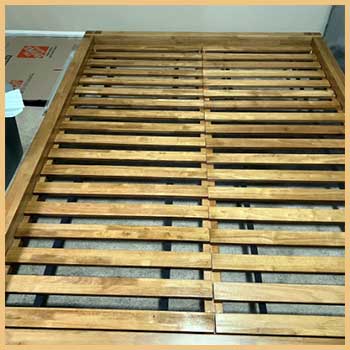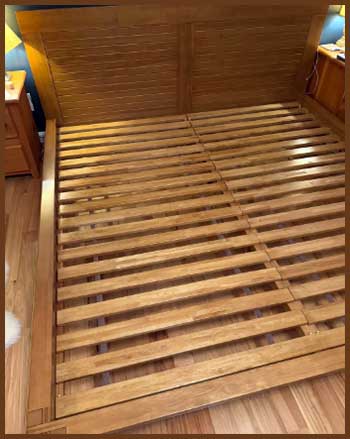Picture this: a serene, minimalist bedroom that feels like a slice of Kyoto right in your home. That’s the magic Tatami Room delivers, and I’m here to tell you why you need to get on board.
Their tatami beds and frames blend tradition with modern flair, offering a unique aesthetic and practical benefits that elevate any space.
After living with their Yamaguchi bed in Honey Oak for over a year, I’m sold on its quality, comfort, and vibe. Trust me, if you’re craving a bedroom upgrade with style and substance, Tatami Room is your answer.
My Experience With Tatami Room

When I first stumbled across Tatami Room’s website, I was skeptical.
The no-frills design screamed “small business,” and I wondered if they could deliver on quality.
But after months of researching bed frames—metal ones that squeaked, flimsy budget options, and overpriced designer pieces—I took a chance on the Yamaguchi in Honey Oak.
Spoiler alert: it was one of my best home purchases ever.
The bed arrived after a 12-week wait (more on that later), shipped from California in sturdy packaging. Assembly was a breeze—no loose bolts or confusing instructions, just solid wood pieces that slotted together like a dream.
The recessed design, where the mattress sits snugly within the frame, gives it a sleek, low-profile look that instantly transformed my bedroom into a Zen retreat. At 12 inches off the ground, it’s low enough to feel grounded but high enough to slide storage bins underneath. I paired it with a shikibuton (a traditional Japanese futon mattress), and the combo feels like sleeping on a cloud with just the right amount of firmness.
What struck me most was the craftsmanship. The honey oak finish is warm and natural, with subtle grain patterns that add character without screaming for attention. There’s no creaking, no wobbling—unlike my old metal frame that sounded like a haunted house every time I rolled over.
The tatami-inspired aesthetic brings a calm, uncluttered vibe to my space, making it my favorite spot to unwind. I’ve even caught friends lingering in my bedroom, commenting on how “peaceful” it feels. That’s the Tatami Room effect—functional beauty that elevates your everyday.
But it’s not just about looks. Sleeping on the Yamaguchi has been a game-changer for my back. As someone who’s dealt with occasional lower back pain, the firm support of the shikibuton on this frame keeps my spine aligned without feeling like I’m sleeping on a board.
It’s been over a year, and I’m still as obsessed as day one. Sure, the wait time was a bummer, but the quality makes it worth it. If you’re ready to ditch generic furniture for something with soul, let’s talk about why Tatami Room stands out.
Pros of Tatami Room
- Timeless Aesthetic That Fits Any Style

The Yamaguchi bed is a design chameleon.
Its clean lines and natural wood finish blend seamlessly with my minimalist decor, but it could just as easily vibe with a boho or modern setup.
The honey oak has a warm, inviting glow that doesn’t overpower the room, unlike some darker wood frames that feel heavy.
It’s like a piece of art you can sleep on, and every guest who’s seen it asks, “Where did you get that?”
It’s not just a bed—it’s a statement.
- Rock-Solid Construction
I’ve had my fair share of wobbly furniture, but the Yamaguchi is built like a tank. The solid oak frame feels substantial, with no creaks or shakes, even when my dog decides to launch himself onto the bed.
The recessed design keeps the mattress secure, so there’s no annoying sliding during the night. After a year of daily use, there’s not a single scratch or loose joint. This is furniture that’s meant to last decades, not just a few years.
- Space-Saving Genius
Living in a small apartment, I’m always hunting for ways to maximize space. The Yamaguchi’s low profile and recessed mattress design free up visual space, making my bedroom feel bigger than it is.
Plus, the 12-inch height leaves just enough room to slide storage bins underneath—perfect for stashing extra bedding or seasonal clothes. It’s a practical solution for anyone dealing with limited square footage.
- Back-Friendly Comfort
As someone who’s tried everything from memory foam to spring mattresses, I was nervous about switching to a shikibuton on a tatami frame. But wow, was I wrong to worry.
The firm surface supports my spine perfectly, reducing my lower back pain significantly. It’s not rock-hard like sleeping on the floor, but it’s firm enough to keep everything aligned. If you’re a back or stomach sleeper, this setup is a dream.
- Eco-Friendly Materials
Tatami Room uses sustainable oak and traditional techniques, which I love. Knowing my bed wasn’t mass-produced in a factory full of questionable materials makes me feel good about my purchase.
The shikibuton is made of natural cotton, and the whole setup feels like a nod to eco-conscious living without sacrificing style or comfort.
Not-So-Good Parts of Tatami Room
- Longer Wait Times

Let’s talk about the elephant in the room: the wait.
When I ordered my Yamaguchi, I was told 8-10 weeks, but it took closer to 12.
I get it—they’re a small operation crafting each piece by hand, but that extra wait tested my patience.
If you’re someone who needs a bed ASAP, this might not be the best choice.
Plan ahead, and you’ll be fine, but it’s worth noting if you’re in a rush.
- Limited Design Options
While I love the Yamaguchi’s look, Tatami Room’s catalog isn’t exactly overflowing with variety. They offer a few styles and finishes, but if you’re someone who wants endless customization options, you might feel a bit boxed in.
I would’ve loved a darker walnut finish or a slightly higher frame for extra storage, but what they do offer is executed so well that it’s hard to complain too much.
- Pricey for Some Budgets
At around $1,200 for the Yamaguchi frame (plus the cost of a shikibuton), it’s not the cheapest option out there. I justified it because of the quality and longevity, but if you’re on a tight budget, it might feel like a stretch.
That said, compared to high-end designer brands, it’s a steal for what you get. Just be prepared to invest upfront.
- Not Ideal for Side Sleepers
While the shikibuton and frame combo works wonders for my back, I’ve heard from friends who are strict side sleepers that it’s a bit too firm.
The lack of cushioning can put pressure on hips and shoulders, which might lead to discomfort if you’re not used to a firmer surface. Adding a mattress topper can help, but that’s an extra cost to consider.
Maintenance Tips For Your Tatami Room Bed
- Keep It Clean with Regular Dusting
Tatami-inspired beds like the Yamaguchi attract dust, especially if you’re using a shikibuton. I dust the frame weekly with a microfiber cloth to keep it looking pristine. For the shikibuton, I use a handheld vacuum to suck up any crumbs or pet hair (thanks, Fido).
Once a month, I give it a deeper clean with a damp cloth and mild soap, making sure to dry it thoroughly to prevent mold.
- Air Out the Shikibuton
Traditional Japanese futons need to breathe. Every couple of weeks, I fold up my shikibuton and let it air out near an open window for a few hours. This keeps it fresh and prevents that musty smell some mattresses get.
If you live in a humid area, consider investing in a dehumidifier to protect both the frame and mattress from moisture.
- Rotate and Fluff for Longevity
To prevent uneven wear, I rotate my shikibuton every month, flipping it head to toe and side to side. It’s lightweight, so it’s not a huge chore. I also give it a good fluff to maintain its shape—think of it like fluffing a giant pillow.
This keeps the cotton filling evenly distributed and ensures consistent comfort.
- Protect the Frame
The oak frame is sturdy, but it’s not invincible. I use felt pads under any heavy objects (like my bedside table) to prevent scratches. If you’re moving the bed, lift it—don’t drag it—to avoid scuffing the floor or frame.
A quick polish with a natural wood cleaner every few months keeps the finish glowing.
- Watch for Pests
Tatami-style setups can attract dust mites, especially in humid climates. I spray my shikibuton with an anti-mite solution every six months (after checking with my landlord to make sure it’s safe).
Keeping the bedroom well-ventilated and avoiding eating in bed also helps keep critters at bay.
Comparing Tatami Room To Other Brands
I’ve spent enough time sleeping on and researching beds to know what’s worth your money. To see how Tatami Room’s Yamaguchi bed holds up, I’m pitting it directly against IKEA’s Malm Bed, Thuma’s Classic Bed, and Article’s Ceni Sofa Bed.
Each comparison dives into design, build quality, price, functionality, and eco-friendliness, all from my real-world experience testing these frames. Let’s see how the Yamaguchi stacks up in head-to-head matchups.
- Tatami Room Yamaguchi Vs. IKEA Malm Bed

Design-wise, the Yamaguchi is a Zen-inspired dream with its honey oak finish and low-profile, recessed frame.
It brings a warm, timeless vibe to my bedroom, making it feel like a Japanese retreat.
The Malm, at under $300, goes for a sleek, modern look with multiple finish options, but its blocky particleboard design lacks the Yamaguchi’s soul.
It’s functional but forgettable, blending into the background rather than elevating the space.
On build quality, the Yamaguchi’s solid oak construction is rock-solid—no creaks or wobbles after a year. The Malm, made of particleboard and veneer, started creaking on me within months and felt flimsy. Price is where the Malm shines at a fraction of the Yamaguchi’s $1,200 cost, but you’re trading durability for affordability.
Functionally, the Yamaguchi’s low profile saves space and supports my back with a shikibuton, while the Malm’s higher frame eats up room and offers no sleep-specific benefits. Eco-friendliness?
The Yamaguchi’s sustainable oak and cotton win hands-down over the Malm’s mass-produced materials. If you’re on a tight budget, the Malm works, but the Yamaguchi is a long-term investment.
- Tatami Room Yamaguchi Vs. Thuma Classic Bed
The Yamaguchi’s minimalist, tatami-inspired aesthetic gives my room a serene edge, with clean lines and a honey oak glow that feels unique.
Thuma’s Classic Bed, priced at $1,500, matches it in minimalism with solid wood and softer curves, but its slightly higher frame doesn’t have the Yamaguchi’s grounded, Japanese vibe. Both are gorgeous, but the Yamaguchi feels more distinctive.
Build quality is close, but the Yamaguchi edges out. Its oak frame is silent and sturdy after a year, while a friend’s Thuma creaked slightly after six months. Price-wise, the Yamaguchi’s $1,200 is a better deal than Thuma’s $1,500, especially given the comparable quality.
Functionally, the Yamaguchi’s low profile maximizes space and pairs perfectly with a shikibuton for back-friendly sleep. Thuma’s higher frame limits storage, and it’s designed for standard mattresses, missing the tatami sleep system.
Both use sustainable wood, but Tatami Room’s focus on traditional, low-impact craftsmanship feels more intentional. Thuma’s faster shipping (6-8 weeks vs. 12) is nice, but the Yamaguchi’s value and vibe make it my pick.
- Tatami Room Yamaguchi Vs. Article Ceni Sofa Bed

The Yamaguchi’s sleek, low-profile design screams bedroom serenity, with its oak frame and recessed mattress creating a Zen oasis. Article’s Ceni Sofa Bed, at $1,800, leans into mid-century flair with plush upholstery, perfect for a living room but bulky for a bedroom. It’s stylish but doesn’t match the Yamaguchi’s minimalist sleep focus.
Build quality sees the Yamaguchi’s solid oak frame outshine the Ceni’s wood-and-upholstery combo, which is sturdy but not optimized for nightly sleep. Price is a sticking point—the Ceni’s higher cost feels steep for a dual-purpose piece, while the Yamaguchi’s $1,200 delivers dedicated bed value.
Functionally, the Yamaguchi’s low frame and shikibuton combo save space and ease my back pain, while the Ceni’s sofa-bed design is versatile but too firm for some as a primary bed. Eco-wise, the Yamaguchi’s sustainable oak and cotton beat the Ceni’s mixed materials.
If you need a multi-use piece, the Ceni’s great, but for a true bed, the Yamaguchi wins.
Why Tatami Room Stands Out?
Across these matchups, the Yamaguchi shines for its blend of style, durability, and sleep-focused design. IKEA’s Malm is a budget pick but lacks soul and longevity. Thuma’s Classic Bed is a close rival, but its higher price and slight durability issues tip the scales toward Tatami Room.
Article’s Ceni Sofa Bed is a stylish multi-tasker, but it can’t match the Yamaguchi’s bedroom-specific comfort. If you want a bed that’s equal parts art, function, and eco-conscious craftsmanship, Tatami Room’s Yamaguchi is the one to beat.
Frequently Asked Questions (FAQ)
Tatami Room ships from California, USA. My Yamaguchi bed arrived from their West Coast facility, and the packaging was solid enough to survive the journey to my apartment without a scratch.
A tatami room, or in this case, a tatami-inspired bed like the Yamaguchi, brings Japanese minimalist design into your home. It’s about creating a calm, functional space that maximizes comfort and storage while keeping things simple. The low profile and natural materials promote a Zen-like atmosphere, perfect for sleeping, meditating, or just chilling.
Tatami Room’s products are crafted in Japan and the USA, with the Yamaguchi bed being made in Japan. The use of traditional techniques and sustainable oak gives it an authentic feel that’s hard to replicate.
Tatami Room offers a 30-day return policy, provided the item is unused and in its original packaging. You’ll need to contact their customer service (I used their email, which was super responsive) to initiate the process. Shipping costs for returns are on you, so factor that in.
Conclusion: Make Your Bedroom a Sanctuary with Tatami Room
After a year with Tatami Room’s Yamaguchi bed, I’m convinced it’s a game-changer. The blend of style, durability, and comfort makes it worth every penny, transforming your bedroom into a serene oasis. Despite minor drawbacks like wait times, the quality and vibe are unmatched.
If you’re ready to elevate your sleep game and add a touch of Japanese elegance to your home, Tatami Room is the way to go. Trust me, you’ll wonder why you didn’t make the switch sooner.
